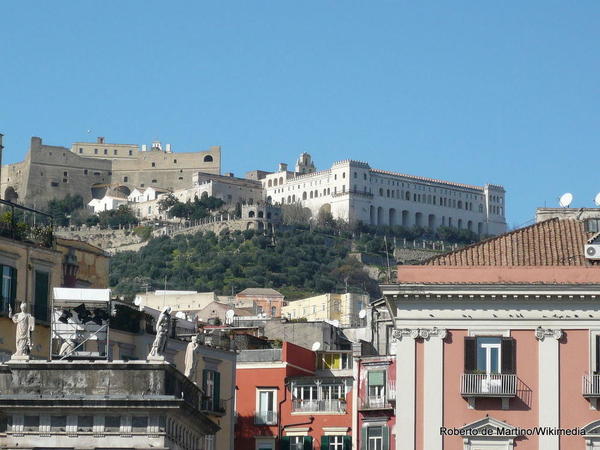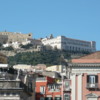Where Gumbo Was #215
The most amazing thing we found in 3 days in Naples was something we hadn't even thought of in our planning: the magnificent Certosa di San Martino.
We ended up at the top of the hill at this former Carthusian monastery-turned-museum because everyone, from our food tour guide on, told us to go. And because our first-choice museum for our last day was closed. Fortunately.
But before we go on to why that was a good thing, it's time to acknowledge this week's careful seekers who were able to identify the site from the clues. In order, Professor Abe, George G, PortMoresby and GarryRF.
San Martino is hard to miss from anywhere in Naples; it's on top of the highest hill, placed there together with the military St. Elmo Castle just above it. But it's not as easy to get to, because the bus that's listed to go there from the nearest metro stop doesn't. No one told us why; they just warned us and pointed the way to walk.
Following a longish walk uphill, interrupted by two escalators, and by a strolling conversation with one of the owners of a cameo factory who apparently often guides visitors to the museum, just past his shop, we arrived, entered, and were blown away by the interior of the church.
There's not much I can add to the pictures. It is the most incredible baroque entity I've ever seen, and appears to be perfectly maintained, at who knows what cost. What you see is only a fraction of what I recorded...a small fraction. Some of this, by the way, is carved stone; some is very impressively painted to look that way
Of course, giving its 14th-century origins, it wasn't always baroque. At its beginning in 1325, the core buildings were largely gothic, but as with every other major church, its patrons over the years lavished care and money and new architects on it, over and over. Most of what we see in the church starts from the late 16th to early 17th centuries.
Of course, it's not all marble and painting: the woodwork is impressive, too. The marquetry panel, second photo, is only one of an entire hallway of panels.
But the church is only, in a sense, the entryway to the rest of the museum's exhibits and spaces, which are richly varied, extensive, and I have to say it: Eccentric. Carriages of the Bourbon rulers of the 18th century. Macabre stone skulls (some decorated with flowers) that mark an unusual monks' graveyard in one of the cloisters. Sculptures of allegorical figures and past abbots at every turn.
But surprisingly, while there's free access to the two cloister courtyards, much of the art and history is within the former monks' cells and inner spaces, and was only open for a brief period when two museum officials accompanied us in. We thought it was going to be a guided tour, but surprisingly, it turned out that they were just there to watch us as we wandered through, and to lock up after us.
Within the locked area, the museum has many of its best paintings, including works by Bernini and other Renaissance masters, as well as paintings showing the city's history under rule by first this country and then another: Angevins, Bourbons, Habsburgs, Napoleon, and only finally the Kingdom of Italy. And there's the incredible brass map above.
It's from some of the outer windows, accessible from within, that you can get some of the best views of the city below, including a view of this waterfront fortification, once one of the city's few seaward gates.
Despite its impressive size and ornate decoration, San Martino, also known as the Charterhouse of Naples, never had a very large monastic community, most often numbering under 50, and never much more than 100. The monastic life there came to an end in Napoleon's time, when many monasteries were shut down.
In 1866 it opened for the first time as a museum, and is one of Italy's earliest national museums. It's from that time that the monk's cells were adapted to serve as exhibit areas, separate from the church.
But, saving some of the best for last, one of the museum's unique collections is its holdings of preseppi, or miniature nativity scenes. Having a presepe was a Naples home tradition for many years; only recently have Christmas trees taken its place. Originally found only in churches and monasteries, they slowly spread to wealthy homes, and then to more.
The one above, in San Martino's former kitchen, was built by Michele Chciniello in the late 1800s; it includes 162 people, 80 animals, 450 miniature objects and a host of angels—as well as a lighting system that cycles through day and night.
This one is somewhat smaller, but it is built so that you can walk around it, following the parade of ordinary folk, exotic visitors, animals, angels and, of course, the Three Kings, infant Jesus and his parents.
There's an old expression, of disputable meaning: "See Naples and Die." However you care to take it, see San Martino first!




Comments (2)